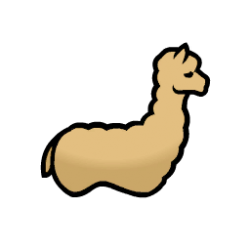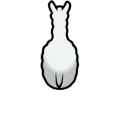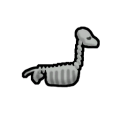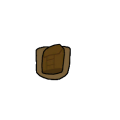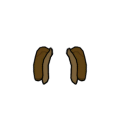Difference between revisions of "Alpaca"
m (x) |
|||
| (21 intermediate revisions by 7 users not shown) | |||
| Line 1: | Line 1: | ||
| − | {{infobox main|animal | + | {{infobox main|animal |
| − | |page verified for version = 1.3.3101 | + | | page verified for version = 1.3.3101 |
| − | |name = Alpaca | + | | name = Alpaca |
| − | |image = Alpaca.png | + | | image = Alpaca.png |
| − | |description = A medium-sized ungulate closely related to the llama, the alpaca is usually raised for its remarkably soft and insulating wool. Alpacas have also been used as pack animals since they hauled cargo on the rugged mountain trails of ancient South America. | + | | description = A medium-sized ungulate closely related to the llama, the alpaca is usually raised for its remarkably soft and insulating wool. Alpacas have also been used as pack animals since they hauled cargo on the rugged mountain trails of ancient South America. |
| − | |type = Animal | + | | type = Animal |
| − | |movespeed = 4.1 | + | | movespeed = 4.1 |
| − | |min comfortable temperature = -20 | + | | min comfortable temperature = -20 |
| − | |max comfortable temperature = 45 | + | | max comfortable temperature = 45 |
| − | |flammability = 0.7 | + | | flammability = 0.7 |
| − | |marketvalue = 350 | + | | marketvalue = 350 |
| − | |filth rate = 16 | + | | filth rate = 16 |
| − | |woolname = alpaca wool | + | | woolname = alpaca wool |
| − | |sheartime = 10 | + | | sheartime = 10 |
| − | |wool = 45 | + | | wool = 45 |
| − | |herdanimal = true | + | | herdanimal = true |
| − | |bodysize = 1 | + | | combatPower = 65 |
| − | |healthscale = 1 | + | | bodysize = 1 |
| − | |hungerrate = 0.275 | + | | healthscale = 1 |
| − | |diet = herbivorous | + | | hungerrate = 0.275 |
| − | |leathername = camelhide | + | | diet = herbivorous |
| − | |wildness = 0.25 | + | | leathername = camelhide |
| − | |manhuntertame = 0 | + | | wildness = 0.25 |
| − | |manhunter = 0 | + | | manhuntertame = 0 |
| − | |roamMtb = 3 | + | | manhunter = 0 |
| − | |trainable = none | + | | roamMtb = 3 |
| − | |mateMtb = 12 | + | | trainable = none |
| − | |packanimal = true | + | | mateMtb = 12 |
| − | |gestation = 6.66 | + | | packanimal = true |
| − | |offspring = 1 | + | | gestation = 6.66 |
| − | |lifespan = 15 | + | | offspring = 1 |
| − | |juvenileage = 0.2 | + | | lifespan = 15 |
| − | |maturityage = 0.3333 | + | | juvenileage = 0.2 |
| − | |tradeTags = AnimalFarm, AnimalCommon | + | | maturityage = 0.3333 |
| − | |attack1dmg = 7.3 | + | | tradeTags = AnimalFarm, AnimalCommon |
| − | |attack1type = Blunt | + | | attack1dmg = 7.3 |
| − | |attack1cool = 2 | + | | attack1type = Blunt |
| − | |attack1part = front left leg | + | | attack1cool = 2 |
| − | |attack2dmg = 7.3 | + | | attack1part = front left leg |
| − | |attack2type = Poke | + | | attack2dmg = 7.3 |
| − | |attack2cool = 2 | + | | attack2type = Poke |
| − | |attack2part = front left leg | + | | attack2cool = 2 |
| − | |attack3dmg = 7.3 | + | | attack2part = front left leg |
| − | |attack3type = Blunt | + | | attack3dmg = 7.3 |
| − | |attack3cool = 2 | + | | attack3type = Blunt |
| − | |attack3part = front right leg | + | | attack3cool = 2 |
| − | |attack4dmg = 7.3 | + | | attack3part = front right leg |
| − | |attack4type = Poke | + | | attack4dmg = 7.3 |
| − | |attack4cool = 2 | + | | attack4type = Poke |
| − | |attack4part = front right leg | + | | attack4cool = 2 |
| − | |attack5dmg = 8 | + | | attack4part = front right leg |
| − | |attack5type = Bite | + | | attack5dmg = 8 |
| − | |attack5cool = 2 | + | | attack5type = Bite |
| − | |attack5part = teeth | + | | attack5cool = 2 |
| − | |attack5chancefactor = 0.7 | + | | attack5part = teeth |
| − | |attack6dmg = 7 | + | | attack5chancefactor = 0.7 |
| − | |attack6type = Blunt | + | | attack6dmg = 7 |
| − | |attack6cool = 2 | + | | attack6type = Blunt |
| − | |attack6part = head | + | | attack6cool = 2 |
| − | |attack6chancefactor = 0.2 | + | | attack6part = head |
| − | |livesin_temperateforest = 0.5 | + | | attack6chancefactor = 0.2 |
| − | |livesin_temperateswamp = 0.5 | + | | livesin_temperateforest = 0.5 |
| − | |livesin_tropicalrainforest = 0.5 | + | | livesin_temperateswamp = 0.5 |
| − | |livesin_tropicalswamp = 0.5 | + | | livesin_tropicalrainforest = 0.5 |
| + | | livesin_tropicalswamp = 0.5 | ||
}} | }} | ||
| − | + | '''Alpacas''' are easily tameable [[herbivore]]s that provide [[alpaca wool|wool]] and act as [[pack animal]]s. | |
| − | '''Alpacas''' are easily tameable [[herbivore]]s | ||
== Obtaining == | == Obtaining == | ||
| − | Alpacas can be found in {{Habitats}}. They can either be tamed by a [[ | + | Alpacas can be found in {{Habitats}}. They can either be tamed by a [[Work #Handle|handler]] or self-tame in a random event. |
Alpacas can be bought and sold in other [[Trade#Faction base|faction bases]] and from [[Trade#Bulk goods trader 2|bulk goods traders]]. Alpacas purchased from traders will be already tamed. | Alpacas can be bought and sold in other [[Trade#Faction base|faction bases]] and from [[Trade#Bulk goods trader 2|bulk goods traders]]. Alpacas purchased from traders will be already tamed. | ||
| − | == | + | == Summary == |
| − | + | {{Pen Animal Note|Alpacas}} | |
| − | + | Alpacas can be sheared for {{icon small|Alpaca wool}} {{P|Wool Amount}} [[alpaca wool]] ({{icon small|silver|16|{{#expr: {{Q|Alpaca wool|Market Value Base}}*{{P|Wool Amount}}}}}}) every {{P|Shearing Interval Days}} days for {{Ticks|1700}} of work. Note that yield and shearing time are modified by the shearer's [[Animal Gather Yield]] and [[Animal Gather Speed]] respectively. | |
| + | |||
| + | Alpacas are also [[pack animal]]s, and will carry up to 35 kg of weight in a [[caravan]]. They cannot be ridden. | ||
| + | |||
| + | == Analysis == | ||
| + | === Pack animal === | ||
| + | Alpacas are the smallest pack animal, carrying the least weight and consuming the least food. But, as early-game pack animals, alpacas are strictly inferior to [[donkey]]s. | ||
| + | * Donkeys are easier to tame, carry more weight, and can be ridden for up to 130% caravan speed. Even when you standardize for nutrition consumption, donkeys still carry more weight. | ||
| + | * [[Horse]]s are slightly harder to tame than alpacas, but horses are even faster (160% caravan speed) and carry even more weight. | ||
| + | Alpacas can be useful for early-game [[caravan]]s, in absence of the other options. In a tropical biome, donkeys and horses are not available. The other native pack animal there is the [[elephant]], which is much harder to tame. Later on, Alpacas can serve a niche for [[transport pod]]s having the lowest mass out of all pack animals, allowing two adults with one pod along with any extra supplies to send to an on-going caravan. | ||
| + | |||
| + | And, unlike donkeys and horses, alpacas produce wool. | ||
| + | |||
| + | === Wool === | ||
| + | An alpaca produces the same amount of wool (at the same intervals) as a [[sheep]], but sheep consume {{%|1-({{Q|Sheep|Real Hunger Rate}}/{{Q|Alpaca|Real Hunger Rate}}) round 2}} less nutrition. Compared to [[sheep wool]], [[alpaca wool]] offers {{Temperature|{{#expr:{{Q|Alpaca wool|Insulation - Cold Factor}} - {{Q|Sheep wool|Insulation - Cold Factor}}}}||delta}} better insulation against Cold and {{Temperature|{{#expr:{{Q|Alpaca wool|Insulation - Heat Factor}} - {{Q|Sheep wool|Insulation - Heat Factor}}}}||delta}} against Heat, and is {{%|({{Q|Alpaca wool|Market Value Base}}/{{Q|Sheep wool|Market Value Base}}) -1 round 2}} more valuable. Thus, the alpaca wool is superior to sheep wool. If the goal is to make bulk wool, regardless of stats, then sheep are more efficient when grazing is insufficient to feed the herds and equally efficient the rest of the time. If the sole purpose is to make money, then alpacas are better than sheep. In addition, alpaca are pack animals. | ||
| + | |||
| + | Alpacas are superior to other wooly animals ([[bison]], [[muffalo]], and [[megasloth]]s) in terms of wool per nutrition consumed. Bison and muffalo would be better for wool per ''colonist work'', though the amount of work to harvest wool isn't terribly large in practice. The insulation and market value of alpaca wool is also superior to that of both [[muffalo wool]] and [[bison wool]]. Megasloth wool offers superior cold insulation and protection, however due to the wildness and intelligence of megasloths, they are not directly comparable to other wooly animals. See [[Megasloth#Wool|their page]] for further analysis. | ||
== Training == | == Training == | ||
| Line 81: | Line 97: | ||
== Health == | == Health == | ||
| − | {{Animal Health Table}} | + | {{Animal Health Table|QuadrupedAnimalWithHooves}} |
| + | |||
| + | == Gallery == | ||
| + | === Normal === | ||
| + | <gallery> | ||
| + | Alpaca east.png|Facing east | ||
| + | Alpaca north.png|Facing north | ||
| + | Alpaca south.png|Facing south | ||
| + | </gallery> | ||
| + | |||
| + | === Dessicated === | ||
| + | <gallery> | ||
| + | Dessicated alpaca east.png|Facing east | ||
| + | Dessicated Alpaca north.png|Facing north | ||
| + | Dessicated Alpaca south.png|Facing south | ||
| + | </gallery> | ||
| + | |||
| + | === Pack === | ||
| + | <gallery> | ||
| + | Alpaca pack east.png|Packing bags facing east | ||
| + | Alpaca pack north.png|Packing bags facing north | ||
| + | Alpaca pack south.png|Packing bags facing south | ||
| + | </gallery> | ||
== Version history == | == Version history == | ||
| Line 91: | Line 129: | ||
[[Category:Animals]] | [[Category:Animals]] | ||
[[Category:Pack Animal]] | [[Category:Pack Animal]] | ||
| − | [[Category:Farm]] | + | [[Category:Farm animal]] |
Latest revision as of 01:00, 16 July 2024
Alpaca
A medium-sized ungulate closely related to the llama, the alpaca is usually raised for its remarkably soft and insulating wool. Alpacas have also been used as pack animals since they hauled cargo on the rugged mountain trails of ancient South America.
Base Stats
- Type
- Animal
- Flammability
- 70%
Pawn Stats
- Combat Power
- 65
- Move Speed
- 4.1 c/s
- Health Scale
- 100% HP
- Body Size
- 1
- Mass - Baby
- 12 kg
- Mass - Juvenile
- 30 kg
- Mass - Adult
- 60 kg
- Pack Capacity
- 35 kg
- Carrying Capacity
- 75 kg
- Filth Rate
- 16
- Hunger Rate
- 0.44 Nutrition/Day
- Diet
- herbivorous
- Life Expectancy
- 15 years
- Manhunter Chance
- 0%
- Manhunter Chance (Taming)
- 0%
- Trainable Intelligence
- None
- Wildness
- 25%
- Minimum Handling Skill
- 1
- Roam Interval
- 3 days
- Mate Interval
- 12 hours
- Maturity Age
- 0.333 years (20 days)
- Juvenile Age
- 0.2 years (12 days)
- Comfortable Temp Range
- -20 °C – 45 °C (-4 °F – 113 °F)
Production
- Meat Yield
- 140
 alpaca meat
alpaca meat - Leather Yield
- 40
 camelhide
camelhide - Wool Amount
- 45
 alpaca wool
alpaca wool - Shearing Interval
- 10 days
- Gestation Period
- 6.66 days
- Offspring Per Birth
- 1
Melee Combat
- Attack 1
- Front left leg
7.3 dmg (Blunt)
11 % AP
2 second cooldown - Attack 2
- Front left leg
7.3 dmg (Poke)
11 % AP
2 second cooldown - Attack 3
- Front right leg
7.3 dmg (Blunt)
11 % AP
2 second cooldown - Attack 4
- Front right leg
7.3 dmg (Poke)
11 % AP
2 second cooldown - Attack 5
- Teeth
8 dmg (Bite)
12 % AP
2 second cooldown
0.7 chance factor - Attack 6
- Head
7 dmg (Blunt)
10 % AP
2 second cooldown
0.2 chance factor - Average DPS
- 2.28
- tradeTags
- AnimalFarm, AnimalCommon
Alpacas are easily tameable herbivores that provide wool and act as pack animals.
Obtaining[edit]
Alpacas can be found in temperate forests, temperate swamps, tropical rainforests, and tropical swamps. They can either be tamed by a handler or self-tame in a random event.
Alpacas can be bought and sold in other faction bases and from bulk goods traders. Alpacas purchased from traders will be already tamed.
Summary[edit]
Alpacas are pen animals. Once tamed, pen animals cannot and do not need to be trained any further. But if left outside of a pen or caravan hitching spot, pen animals will eventually roam outside your colony. Making a caravan is not required to tie animals to a caravan hitching spot.
Alpacas can be sheared for ![]() 45 alpaca wool (
45 alpaca wool (![]() 171) every 10 days for 1,700 ticks (28.33 secs) of work. Note that yield and shearing time are modified by the shearer's Animal Gather Yield and Animal Gather Speed respectively.
171) every 10 days for 1,700 ticks (28.33 secs) of work. Note that yield and shearing time are modified by the shearer's Animal Gather Yield and Animal Gather Speed respectively.
Alpacas are also pack animals, and will carry up to 35 kg of weight in a caravan. They cannot be ridden.
Analysis[edit]
Pack animal[edit]
Alpacas are the smallest pack animal, carrying the least weight and consuming the least food. But, as early-game pack animals, alpacas are strictly inferior to donkeys.
- Donkeys are easier to tame, carry more weight, and can be ridden for up to 130% caravan speed. Even when you standardize for nutrition consumption, donkeys still carry more weight.
- Horses are slightly harder to tame than alpacas, but horses are even faster (160% caravan speed) and carry even more weight.
Alpacas can be useful for early-game caravans, in absence of the other options. In a tropical biome, donkeys and horses are not available. The other native pack animal there is the elephant, which is much harder to tame. Later on, Alpacas can serve a niche for transport pods having the lowest mass out of all pack animals, allowing two adults with one pod along with any extra supplies to send to an on-going caravan.
And, unlike donkeys and horses, alpacas produce wool.
Wool[edit]
An alpaca produces the same amount of wool (at the same intervals) as a sheep, but sheep consume 18% less nutrition. Compared to sheep wool, alpaca wool offers 4 °C (7.2 °F) better insulation against Cold and 6 °C (10.8 °F) against Heat, and is 41% more valuable. Thus, the alpaca wool is superior to sheep wool. If the goal is to make bulk wool, regardless of stats, then sheep are more efficient when grazing is insufficient to feed the herds and equally efficient the rest of the time. If the sole purpose is to make money, then alpacas are better than sheep. In addition, alpaca are pack animals.
Alpacas are superior to other wooly animals (bison, muffalo, and megasloths) in terms of wool per nutrition consumed. Bison and muffalo would be better for wool per colonist work, though the amount of work to harvest wool isn't terribly large in practice. The insulation and market value of alpaca wool is also superior to that of both muffalo wool and bison wool. Megasloth wool offers superior cold insulation and protection, however due to the wildness and intelligence of megasloths, they are not directly comparable to other wooly animals. See their page for further analysis.
Training[edit]
This animal can be trained as follows:
| Guard: | |
|---|---|
| Attack: | |
| Rescue: | |
| Haul: | |
*As of version 1.1.2610, all animals can be tamed. The percentage of likelihood of success depends on factors such as the Animals Wildness Percentage, Pawn Handling Skill, and others. More information can be found on the animals page.
Health[edit]
| Part Name | Health | Quantity | Coverage[1] | Target Chance[2] | Subpart of | Internal | Capacity[3] | Effect if Destroyed/Removed |
|---|---|---|---|---|---|---|---|---|
| Body | 40 | 1 | 100% | 26% | N/A[4] | - | Death | |
| Spine | 25 | 1 | 3% | 3% | Body | Moving |
−100% Moving[5] | |
| Stomach | 20 | 1 | 3% | 3% | Body | Digestion |
−50% Digestion | |
| Heart | 15 | 1 | 3% | 3% | Body | Blood Pumping |
Death | |
| Lung | 15 | 2 | 3% | 3% | Body | Breathing |
−50% Breathing. Death if both lost. | |
| Kidney | 15 | 2 | 3% | 3% | Body | Blood Filtration | −50% Blood Filtration. Death if both lost. | |
| Liver | 20 | 1 | 3% | 3% | Body | Digestion |
Death | |
| Neck | 25 | 1 | 22% | 5.5% | Body | Eating Talking Breathing |
Death | |
| Head | 25 | 1 | 75% | 2.475% | Neck | - | Death | |
| Skull | 25 | 1 | 25% | 1.2375% | Head | - | Cannot be destroyed Increasing Pain based on damage. | |
| Brain | 10 | 1 | 70% | 2.8875% | Skull | Consciousness |
Death Damage always results in scarring. | |
| Eye | 10 | 2 | 12% | 1.98% | Head | Sight |
−25% Sight. −100% if both lost. Damage always results in scarring. 0% Hit Chance against Blunt damage. | |
| Ear | 12 | 2 | 8% | 1.32% | Head | Hearing |
−25% Hearing. −100% if both lost. | |
| Nose | 10 | 1 | 10% | 1.65% | Head | - | - | |
| AnimalJaw | 10 | 1 | 10% | 1.65% | Head | Manipulation |
−100% Manipulation. Can no longer use Bite attack. | |
| Front Leg | 30 | 2 | 7% | 5.95% | Body | Moving |
−25% Moving. −50% if both lost. Can no longer use Hoof attack.[6] | |
| Front Hoof | 10 | 2 | 15% | 1.05% | Front Leg | Moving |
−25% Moving. −50% if both lost. | |
| Rear Leg | 30 | 2 | 7% | 5.95% | Body | Moving |
−25% Moving. −50% if both lost. | |
| Rear Hoof | 10 | 2 | 15% | 1.05% | Rear Leg | Moving |
−25% Moving. −50% if both lost. |
- ↑ Coverage determines the chance to hit this body part. It refers to the percentage of the super-part that this part covers, before its own sub-parts claim their own percentage. For example, if the base coverage of the super-part is 100%, and the coverage of the part is 20%, 20% of hits would hit the part, and 80% the super-part. If the part had its own sub-part with 50% coverage, the chances would be 10% sub-part, 10% part, 80% super part.
- ↑ Target Chance is the actual chance for each part to be be selected as the target when each part's coverage has been taken into account(I.E. Neck covers 7.5% of Torso but Head covers 80% of Neck so it actually has only a 1.5% chance to be selected). This is not pure hit chance, as different damage types propagate damage in different ways. See that page for details.
- ↑ Note that capacities can affect other capacities in turn. Only the primary effect is listed. See specific pages for details.
- ↑ This is the part that everything else connects to to be considered 'connected'.
- ↑ If Moving drops below 16% a pawn cannot move.
- ↑ A Blunt/Poke attack with cooldown of 2s. The actual Hoof is unrelated
Gallery[edit]
Normal[edit]
Dessicated[edit]
Pack[edit]
Version history[edit]
- 0.12.906 - Can now be shorn for wool
- Beta 19/1.0 - move speed 3.8 -> 3.2, leg damage 7 -> 6
- Version 1.3 - Animal Overhaul
